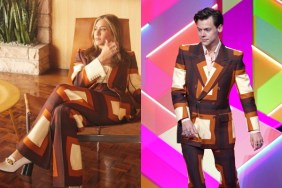When one looks at a work of art, and one spies a distinctive style, one might must wonder whether the artist is equally fashionable. Does a show like, for instance, Hannibal – which for three seasons touted the most beautifully tailored clothes on television, filmed with an almost pornographic eye for lusciousness – emerge from a producer who himself wears only the finest, eats only the finest, and is a guest editor for only the finest website?
Funnily enough, we talked to Crave’s latest guest editor Bryan Fuller about these very topics. As the creator of Hannibal, and other impressively stylish shows like Pushing Daisies, he has turned opulence into one of his trademarks. It’s a predilection that has seeped into his own lifestyle choices, and as we talked on the phone last week we delved into what his trained eye has decided was appropriate for Hannibal, what was appropriate for his personal life, and whether or not he’d eat human flesh if it were prepared just right.
The answers may surprise you. This is our latest interview with Bryan Fuller.

NBC
Related: Bryan Fuller on ‘American Gods’ and ‘Amazing Stories’
Crave: Hannibal is considered one of the most stylish shows on television. Was that important to you from the beginning, or is that just innate to the way you make everything?
Bryan Fuller: Yes and yes. It was particularly important for Hannibal to have an aesthetic to the television story that probably was most closely represented in the Ridley Scott film [Hannibal, 2001]. But for me, based on my obsession with the novels, one of the things that I didn’t get enough of until the novel Hannibal, which I adore, is this sense of Hannibal Lecter as an aesthete, and the show having as much style as the title character.
So it was vital to have an elegance in the style. If you look at Pushing Daisies, not necessarily an elegant style. It’s a vivid, fun style and a storybook style but it’s not bespoke in a gentlemanly way that Hannibal was. It was very important to me that the show be as stylish as the title character.
Where do you go to develop the style for the various characters on Hannibal, in particular? Were the ideas set or did you look at certain materials to try to find it?
For me, I understood – because I’m obsessed with both of these artists – that Hannibal was going to be a juxtaposition of the artistic styles of Francis Bacon, against Edward Hopper. That really was the informing vision for the show. Will Graham is very much Edward Hopper, Hannibal Lecter is very much Francis Bacon, and what happens when those two worlds come crashing together?
“The rules of style are, I suppose, the same rules that I apply to writing, which is specificity and authenticity.”
Did you have to buy the clothes on the show or were they made for you? How did you go about designing the looks?
I would say 90% of Hannibal’s suits were bespoke, and there’s a fantastic tailor in Toronto who built all of them. He’s so shockingly good. He came in and measured me once and then made me a Hannibal suit, and it fit so perfectly… better than any suit I have ever put on my body.
So we had these great tailors in Toronto building suits from scratch for Mads Mikkelsen and my edict for him was, three-piece plaid suits. That was going to be the main voice because I wanted it to be flashy enough for the devil to get his due, yet refined enough that he is able to move amongst us with his peacock feathers flaunted.
Is that how you dress now? In a bespoke suit, every day you can?
I love to dress up. I love to put on a suit but I don’t wear a suit every day. Generally I like to wear nice clothes but I think when I start directing I’ll be one of those directors who wears a suit every day.

Photo: Gabriel Goldberg
What are your rules of style? What have you learned works and how can we apply that in our own lives?
The rules of style are, I suppose, the same rules that I apply to writing, which is specificity and authenticity. So a specific cut or a specific pattern is always going to be more welcome to me than jeans and a t-shirt. Los Angeles is an ocean of jeans and t-shirts and I find it so sad that that is the way that people choose to express themselves in Los Angeles. [Laughs.]
Between jeans, t-shirts, yoga pants and athletic wear, I just want to teleport to London or New York and use those style icons that walk the streets to scrub my eyeballs from what I see in Los Angeles every day
Besides jeans and t-shirts are there any “don’ts?” What do you recommend we all avoid in our daily lives?
As far as style goes?
Sure.
Actually I think if the shoe fits you should wear it. If it speaks to you, you should wear it. I love adventure. I would hesitate to give anybody a “don’t” in fashion, but that doesn’t preclude t-shirts.

NBC
Related: Bryan Fuller Presents | Ten of the Most Stylish Horror Movies Ever
What about food? Is food a fashion? Because Hannibal seemed to make it so.
Well, the more I think about the things I put in my body – food or otherwise – the notion of being mindful of what I’m exposing myself to has increased the older I get. So when I started working on Hannibal I had been, I suppose, a “foodie” for lack of a better term and enjoyed food in the same way that I enjoy storytelling… which is, give me a specific and give me a point of view, and an approach that I won’t find any place else, and I’m going to be delighted.
So I tend to really enjoy restaurants that offer you something that most do not. And also nutritionally, when I am left to my own devices, I’m eating so simply that when I go out I want my palate to be dazzled in unexpected ways. So I’m a very adventurous eater. Even though I’m somebody who is generally pescatarian, and I try to stay away from land animals, I do find myself in situations.
If I’m at a dinner with José Andrés and he says, “This is an amazing piece of meat. You have to try it.” I will try that piece of meat. So I’m fairly adventurous in how I approach story and how I approach food.
How adventurous are you getting? If you had the opportunity to eat human flesh, and it was okay, would you? I think that’s the question we all ask ourselves after watching Hannibal.
If José Andrés put a piece of meat in front of me and said, “This is the perfect piece of meat, prepared lavishly, and it is something that you should experience,” yeah, I’d take a bite of a human being. As somebody who’s an animal lover, and eating pork is akin to cannibalism to me, and beef is akin to cannibalism because I think about the emotional sophistication of the animals on the plate… I feel like I’ve already been a cannibal to some extent, with that philosophy.
So taking a bite out of somebody’s ass cheek doesn’t keep me up at night.
Top Photo: Gabriel Goldberg
William Bibbiani (everyone calls him ‘Bibbs’) is Crave’s film content editor and critic. You can hear him every week on The B-Movies Podcast and watch him on the weekly YouTube series Most Craved and What the Flick. Follow his rantings on Twitter at @WilliamBibbiani.








